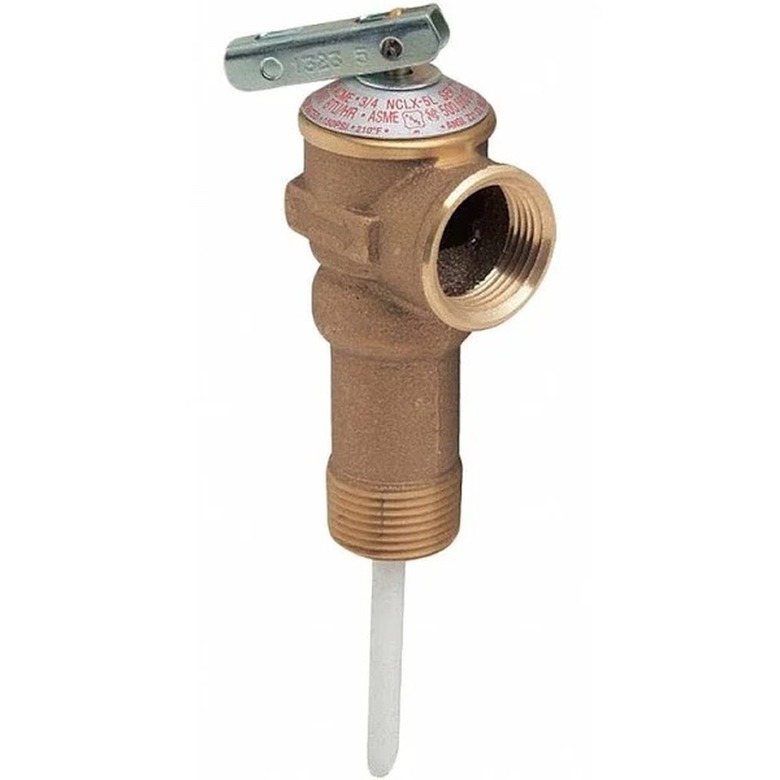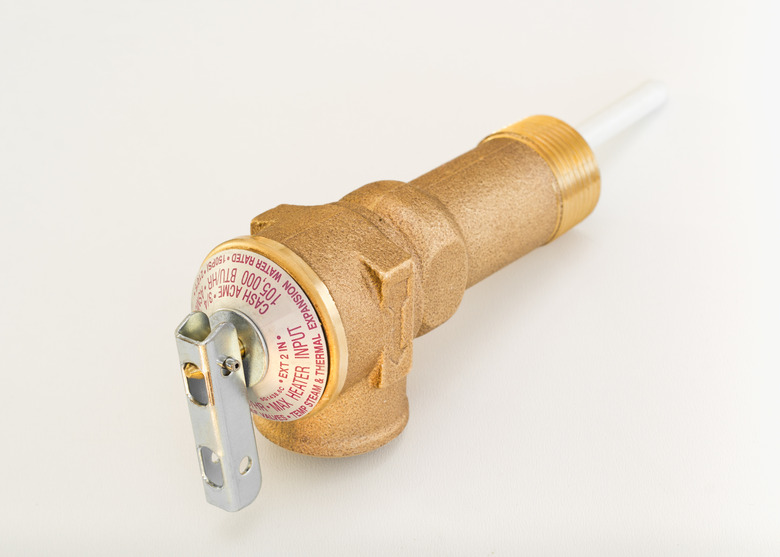How To Test And Replace The TPR Valve On Your Water Heater
The temperature pressure relief valve on a water heater, also known as the TPR valve, is a safety device designed to prevent an excessive buildup of pressure and a possible explosion. If you're wondering whether your water heater has one, wonder no more — if it has a tank (as opposed to being a tankless, on-demand model), it has one.
The TPR valve is a brass fitting mounted on the top or side of the tank. It looks like a spigot with a 3/4-inch male threaded inlet and a 3/4-inch male or female threaded outlet. Instead of a handle, it has a spring-loaded lever, and when installed according to code, it has a discharge pipe that extends to a few inches above the floor.
Since the job of the water heater pressure relief valve is to release excessive pressure, most of the time, it isn't doing anything at all. It's made of brass, so it doesn't corrode, but scale can build up on the lever mechanism. When there's enough buildup to prevent the lever from closing all the way, the TPR valve can leak even when the tank pressure is in a safe range, and that's one reason to replace it. Another more important reason is when it won't open when it should.
A Working TPR Valve Is Important
It's one thing when the TPR valve leaks and drips a steady stream of water onto the floor, making a mess and filling the water heater room with humidity. It's another when the valve gets stuck in the closed position by scale and hard water deposits and doesn't do the job it's supposed to do, which is to open and relieve excess pressure. That can be catastrophic.
Water in the hot water heater tank expands as it gradually heats up, and if it doesn't have anywhere to go, it puts pressure on the hot water tank liner, which will eventually leak. In a worst-case scenario in which the water heater temperature rises past the safe limit of 120- to 140-degrees Fahrenheit because of a thermostat malfunction, the tank can literally explode, causing flooding and possible injury.
Expanding water backs up into the cold water supply pipe that extends into the tank, and an open path back to the water source greatly reduces the possibility of explosion. The main water valve on some homes, however, has a check valve that prevents backflow, and that creates a closed system in which pressure can definitely build to dangerous levels. Not only is a working TPR valve essential in this type of system but an expansion tank should also be installed on the cold water supply line.
How to Test a Water Heater TPR Valve
Homeowners should test the water heater TPR valve every six months. The procedure is simple and involves opening the valve manually. Conduct the test on a day when you're sure hardware stores are open so you know you can get a replacement if something goes wrong.
Before testing the valve, make sure a discharge tube made of a corrosion-resistant material, such as copper, PVC, or CPVC, is connected and forms a drain line that extends down toward the floor. If there isn't a pan or bucket on the floor already (there should be), put one under the discharge tube opening to catch water. Lift the lever on the valve partway — just enough to allow water and steam to escape. Don't open the lever all the way or it may get stuck in the open position.
You should hear water bubbling into the discharge tube and see it pouring from the end of the tube. If no water comes from the valve, it's blocked and needs to be replaced immediately. If water continues to come out of the valve after you release the lever, lift the lever again and let it fall a few more times. If necessary, give the valve a few light taps. Replace it if you can't get it to close.
Things Needed
How to Replace a Water Heater TPR Valve
The power to the water heater must be off when you replace the TPR valve. You don't necessarily have to wait for the water in the tank to get completely cold, but you should definitely give it time to cool down somewhat to avoid getting scalded.
1. Turn Off Power to the Water Heater
If you have an electric water heater, turn off the circuit breaker in the main panel that controls it. If you have a gas water heater, turn off the valve in the gas supply line and then turn off the gas valve on the water heater.
2. Turn Off the Water and Relieve Pressure
Locate the valve for the cold water supply to the water heater and turn it off. Open a hot water faucet somewhere in the house to relive pressure in the hot water line. Leave the faucet open.
3. Partially Drain the Tank
Screw a garden hose onto the drain valve on the bottom of the tank and run the hose to a floor drain, a utility sink, or outdoors. Open the drain valve and let enough water drain to bring the level in the tank below the TPR valve. You'll know you've drained enough when you open the valve and nothing comes out.
4. Remove the Discharge Tube
Unscrew the discharge tube from the TPR valve using a pipe wrench. If the valve is on the top of the tank, the discharge tube may have an elbow, and since the elbow is often soldered or glued, you have to use a hacksaw to cut the pipe just before it.
5. Unscrew the TPR Valve
Use the pipe wrench to turn the TPR valve counterclockwise. Once it's loose enough, continue turning it by hand until you can remove it. Clean the threads of the opening in the water heater with a small, stiff brush.
6. Install the New Valve
Wrap plumbing tape clockwise around the threads of the new TPR valve. Three times around is usually enough, leaving about 1/4 inch of the threads exposed at the bottom to keep excess tape out of the tank. Screw the valve into the valve opening and tighten it with the pipe wrench.
7. Replace the Discharge Tube
Screw the discharge tube onto the new valve. If you had to cut the tube, repair the cut by gluing or soldering a PVC or copper coupling.
8. Refill the Tank and Restore Power
Turn on the cold water valve and let the tank refill. You'll know the tank is full when air stops sputtering from the faucet you left open, and water runs in a steady stream. When that happens, turn off the faucet. Restore power to an electric water heater by turning the breaker back on. If you have a gas water heater, turn on the gas and relight the pilot following the instructions in your owner's manual.

